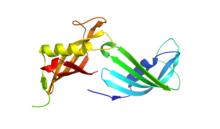- Cystatin
-
Proteinase inhibitor I25, cystatin 
Crystal structure of an immunomodulatory salivary cystatin from the soft tick Ornithodoros moubata.[1] Identifiers Symbol Prot_inh_cystat Pfam PF00031 InterPro IPR000010 SMART SM00043 PROSITE PDOC00259 Available protein structures: Pfam structures PDB RCSB PDB; PDBe PDBsum structure summary The cystatins are a family of cysteine protease inhibitors with homology to chicken cystatin. Cystatins typically comprise about 115 amino acids, are largely acidic, contain four conserved cysteine residues known to form two disulfide bonds, may be glycosylated and/or phosphorylated, with similarity to fetuins, kininogens, stefins, histidine-rich glycoproteins and cystatin-related proteins.[2][3][4] They mainly inhibit peptidases belonging to peptidase families C1 (papain family) and C13 (legumain family).
Contents
Types
The cystatin family includes:
- The Type 1 cystatins, which are intracellular cystatins that are present in the cytosol of many cell types, but can also appear in body fluids at significant concentrations. They are single-chain polypeptides of about 100 residues, which have neither disulfide bonds nor carbohydrate side-chains.
- The Type 2 cystatins, which are mainly extracellular secreted polypeptides synthesised with a 19- to 28-residue signal peptide. They are broadly distributed and found in most body fluids.
- The Type 3 cystatins, which are multidomain proteins. The mammalian representatives of this group are the kininogens. There are three different kininogens in mammals: H- (high-molecular-mass, IPR002395) and L- (low-molecular-mass) kininogen, which are found in a number of species, and T-kininogen, which is found only in rat.
- Unclassified cystatins. These are cystatin-like proteins found in a range of organisms: plant phytocystatins, fetuin in mammals, insect cystatins, and a puff adder venom cystatin, which inhibits metalloproteases of the MEROPS peptidase family M12 (astacin/adamalysin). Also, a number of the cystatin-like proteins have been shown to be devoid of inhibitory activity.
Human cystatins
See also
- Cystatin C - a novel marker of kidney function.
References
- ^ PDB 3L0R; Salát J, Paesen GC, Rezácová P, Kotsyfakis M, Kovárová Z, Sanda M, Majtán J, Grunclová L, Horká H, Andersen JF, Brynda J, Horn M, Nunn MA, Kopácek P, Kopecký J, Mares M (June 2010). "Crystal structure and functional characterization of an immunomodulatory salivary cystatin from the soft tick Ornithodoros moubata". Biochem. J. 429 (1): 103–12. doi:10.1042/BJ20100280. PMID 20545626.; rendered with PyMOL
- ^ Rawlings ND, Barrett AJ (1990). "Evolution of proteins of the cystatin superfamily". J. Mol. Evol. 30 (1): 60–71. doi:10.1007/BF02102453. PMID 2107324.
- ^ Abrahamson M, Alvarez-fernandez M, Nathanson CM (2003). "Cystatins". Biochem. Soc. Symp. (70): 179–199. PMID 14587292.
- ^ Bode W, Turk V (1991). "The cystatins: protein inhibitors of cysteine proteinases". FEBS Lett. 285 (2): 213–219. doi:10.1016/0014-5793(91)80804-C. PMID 1855589.
Further reading
- Lee C, Bongcam-Rudloff E, Sollner C, Jahnen-Dechent W, Claesson-Welsh L (2009). "Type 3 cystatins; fetuins, kininogen and histidine-rich glycoprotein". Front. Biosci. 14: 2911–22. doi:10.2741/3422. PMID 19273244.
External links
This article includes text from the public domain Pfam and InterPro IPR000010

This protein-related article is a stub. You can help Wikipedia by expanding it.
